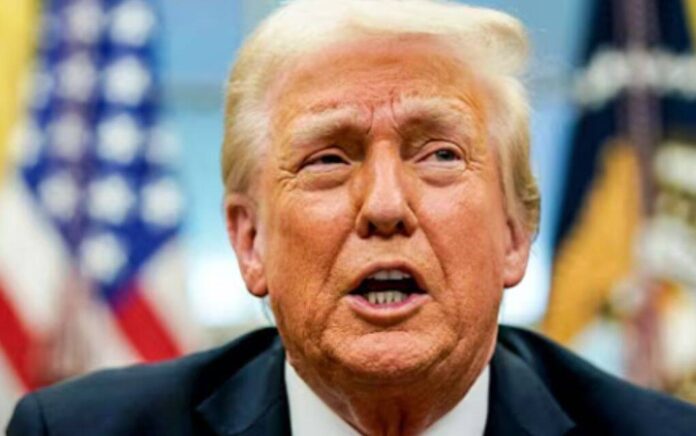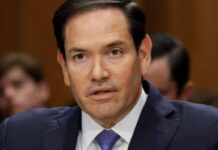
Congress is in a staredown with President Trump. The D.C. establishment is shaking in fear.
Especially after President Trump sent a demand to Congress to send him one document that will change everything.
Trump Pushes for Balanced Budget Amid Growing Concerns Over National Debt
President Donald Trump is renewing his push for a balanced federal budget, calling on Congress to take action on something it hasn’t done in two decades. Trump has long expressed his desire for a balanced budget, but his proposals, including extending the tax rates from the 2017 Tax Cuts and Jobs Act, could complicate efforts for both the House and Senate. Extending these tax cuts is expected to cost approximately $4 trillion, presenting a significant challenge in achieving fiscal balance.
On Thursday, Trump reignited his calls for balancing the federal budget, posting a message on Truth Social that reflected his determination. “Balance budget now??? Let’s give it a shot. Lots of money coming in from tariffs. Do it!” Trump wrote in all caps, highlighting his belief that tariff revenue could play a key role in offsetting the cost of his budgetary ambitions.
However, the actual impact of Trump’s tariffs on the federal budget remains uncertain. Previous budget projections from independent groups have suggested that tariff revenue alone may not be enough to cover the substantial spending increases that Trump has proposed. This leaves Congress facing tough decisions about how to balance fiscal responsibility with the ambitious tax cuts and spending plans currently on the table.
The House of Representatives has introduced a $4.5 trillion all-encompassing bill that seeks to extend the tax cuts put in place during Trump’s first term. Meanwhile, the Senate has proposed a more modest, fully offset $342 billion bill, which delays any action on the tax cuts for the time being. If the House proposal moves forward, it would allow for a $2.8 trillion increase in the federal deficit through 2034.
Looking at the long-term fiscal landscape, the U.S. government has only ended with a budget surplus four times in the past 50 years, with the most recent surplus occurring in 2001. Since then, Congress has consistently run a deficit every year, a trend that has raised alarms about the nation’s growing debt burden.
Maya MacGuineas, president of the Committee for a Responsible Federal Budget, has voiced her concerns over the current trajectory of federal spending. “The $2.8 trillion target is unquestionably too large and an astronomical figure given our massive debt burden,” she said. “We should not be borrowing another $2.80, let alone another $2.8 trillion. The House should revise the budget resolution to be deficit reducing or at the very least budget neutral.”
The Peter G. Peterson Foundation, another fiscal watchdog, has urged lawmakers to take a more cautious approach in addressing the nation’s fiscal challenges. “There are plenty of options available for lawmakers to fully offset the cost of policies they wish to extend or enact, and they should avoid budget gimmicks or other fiscal shortcuts,” the group stated. “As legislators consider policy initiatives to address this year, they should keep in mind the unsustainable fiscal situation that already exists and, at the very least, do no fiscal harm.”
Adding to the concern, the Government Accountability Office (GAO) has long warned that the nation is on an unsustainable fiscal path. In a report released just last week, the GAO repeated its dire warnings about the potential economic consequences of unchecked government spending. According to the GAO’s analysis, if current trends continue, public debt could soar to 219% of the nation’s GDP by 2051, presenting a significant risk to both economic stability and national security.
Gene Dodaro, U.S. Comptroller General and head of the GAO, emphasized the urgency of addressing these challenges. “We project that public debt will reach an unprecedented level by 2027,” Dodaro said. “We’re calling on Congress and the Administration to act now to develop and implement a strategy to address this acute challenge. Inaction could result in great difficulties for many Americans and impede policymakers’ flexibility to respond to future economic recessions or unexpected events.”
Very few U.S. Presidents have ever overseen federal budget surpluses, with a surplus becoming more and more rare since the post-World War II era began. According to historians, just nine U.S. Presidents have been able to balance the budget and then stick to the budget at least once. Bill Clinton was the last President able to accomplish that, though he was still oversaw a net expansion of federal debt.
The last President able to actually cut into the U.S. federal debt as a whole was Calvin Coolidge in the 1920s. He balanced the budget every year he was in office and was able to pay off a third of the U.S. federal debt by the time he left office in 1929. This would mean the last time the U.S. federal government was actually able to pay off debt in any substantial way was about a hundred years ago.
Donald Trump claimed on the campaign trail when he was running first against Joe Biden for the second time and then against Kamala Harris that he was preparing to start paying off the federal debt in a second term. What got in the way, in Trump’s opinion, was the 2020 pandemic panic which saw the U.S. federal government explode federal spending to levels unseen.
Simply put, if Donald Trump was able to balance the budget, he would cement himself in history as an extremely capable executor in the White House. If he were able to actually create a budget surplus, he would likely go down as the best President since Calvin Coolidge in the eyes of many economists, historians, and political scientists.



















